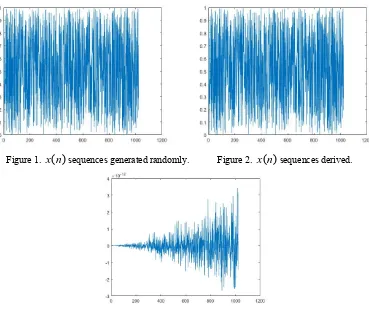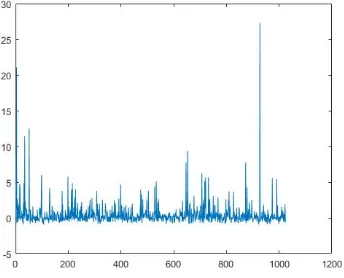2017 2nd International Conference on Artificial Intelligence and Engineering Applications (AIEA 2017)
ISBN: 978-1-60595-485-1
Simulation of 4G Mobile Communication Process
Based on MATLAB
WEIWEI TIAN and ZIXUAN NI
ABSTRACT
Mobile communication has become the most promising and the most potential hot technology in contemporary communications. 4G is a comprehensive system for multiple access technologies that enable seamless links to various technologies based on a common platform. In this paper, the development of mobile communication and characteristics were summarized, and MATLAB simulation software is used to simulate the communication process in the wireless channel.
KEYWORDS
Mobile communications, 4G, simulation, MATLAB.
INTRODUCTION
From 1G to 4G, mobile communication technology in China has developed rapidly in recent years. 4G technology has been greatly improved in terms of signal coverage area and service capacity, and has become a widely used technology in various fields. 4G mobile communication technology solves the problem of transmission rate, meanwhile, through the continuous update and advantage of communication process, the security of communication has been greatly improved. In view of the current situation, 4G technology has been applied to all fields of society, providing important guarantee for the development of society and even the country [1]. Because of the complexity of 4G mobile communications, computer simulation is the first step in the design and research of mobile communication (With the development of technology, a lot of simulation tools are available such as MATLAB), and the mobile communication system can be well simulated. This paper simulates the process of 4G mobile communication through MATLAB.
OVERVIEW OF MOBILE COMMUNICATION
The Development Process of Mobile Communication
The development of mobile communication technology has undergone a long process from 1G to 4G. The time of different systems is different, and the value of the mobile communication system is different from each other. From the 1G mobile
_________________________________________
communication system to the 4G mobile communication system, the function of the system has been constantly improved, and the corresponding problems have been constantly solved, which is a great progress for the field of mobile communications.
The first generation mobile communication system, which is developed on the basis of FDMA technology, achieves the purpose of analog communication by optimizing the technology. 2G mobile communication system is digitized, which is one of its main advantages. 3G mobile communication system is based on 2G mobile communication system. The obvious advantage of 3G mobile communication system in our country lies in the independent research and development of Technology [2]. The drawback of 3G system is that the transmission speed cannot be guaranteed. The speed of data transmission based on this mobile communication system is only 2Mb/s, which is very unfavorable to the improvement of communication effect. To solve this problem, 4G mobile communication technology has emerged. 4G mobile communication technology to solve the transmission problems, at the same time, the safety of communication has been greatly improved by updating the communication process and advantages.
Features of 4G Mobile Communications.
(1)High data transfer rate
For large scale high-speed mobile users (250km/h), the data rate is 2 Mbit/s. For medium-speed mobile users (60km/h), the data rate is 20 Mbit/s; for low speed mobile users (indoor or pedestrian), the data rate is 100 Mbit/s.
(2)Achieve true seamless roaming
4G mobile communications systems achieve a global standard that enables seamless connectivity between various media, communications hosts, and networks, and it realize that a mobile phone can communicate anywhere in the world.
(3)Highly intelligent network
4G communication system with intelligent technology is a highly autonomous, adaptive network. Using intelligent signal processing technology for different channel conditions in complex environment for normal sending and receiving, it have very strong intelligence, adaptability and flexibility.
(4)Good coverage performance
The 4G communication system has excellent coverage performance and provides high speed variable speed transmission. For indoor environments, the radius of the community will be smaller because of the high speed transfer [3].
SIMULATION OF 4G MOBILE COMMUNICATION PROCESS
In fact, mobile communication is the process of transmitting signals from the carrier to the receiver and then receiving the transmitted signals from the received signals. We will explore the communication process of 4G through the analysis of the original signalx(n).
Here we define the discrete signalx(n), and the environment in which the signal is
transmitted namely channel is defined ash(n). Then the received signaly(n)is:
) ( ) ( )
(n h n x n
It is equal to:
M m m n x m h n y 0 ) ( ) ( ) ( (2) ) 0 ( ) 0 ( ) 0( h x
y ) 0 ( ) 1 ( ) 1 ( ) 0 ( ) 1
( h x h x
y
) 0 ( ) 2 ( ) 1 ( ) 1 ( ) 2 ( ) 0 ( ) 2
( h x h x h x
y
Through the above formula, in the case of getting y(n) , the theoretical
transmission data x(n) is obtained by decreasing the h(m)x(nm) of the loop until
the last item remaining h(0)x(n) is divided by h(0). The steps are as follows:
) 0 ( ) 0 ( ) 0 ( h y x ) 0 ( ) 0 ( ) 1 ( ) 1 ( ) 1 ( h x h y
x
) 0 ( ) 0 ( ) 2 ( ) 1 ( ) 1 ( ) 2 ( ) 2 ( h x h x h y
x
The experimental results obtained through the experiment are shown in figure 1, figure 2, figure 3.
[image:3.612.118.487.397.708.2]
Figure 1. x(n)sequences generated randomly. Figure 2. x(n)sequences derived.
...
From the experimental results, it can be concluded that the sequence obtained by this method has a deviation compared with the original sequence, and the deviation increases obviously with the increase of the sequence number. The reason for this is that the method is an iterative computation process where a small deviation of the data is magnified indefinitely as the sequence increases until completely deviated from the original numerical trajectory. This is the system becoming unstable.
) ( ) ( )
( ~ ~
~
k x k h k
y (3)
The information to be transmitted isx~(k), its inverse Fourier transform isx(n).
And y(n)h(n)x(n), the Fourier transform of y(n) is ( )
~
k
y . Divide the ( )
~
k h by
) (
~
k
y to get the original transmit signal sequence ( )
~
k
x .
[image:4.612.317.476.307.437.2]The experimental results obtained through the experiment are shown in figure 4, figure 5, figure 6.
[image:4.612.111.270.307.435.2]
Figure 4. x(n)sequences generated randomly. Figure 5. x(n)sequences derived.
[image:4.612.217.389.478.617.2]
From the experimental results, it can be concluded that the signal sequence is not required to be iterated by the way of frequency conversion, so the system will not appear unstable. Because the calculation process only involves multiplication and division, so the error can be controlled. It can be seen from the result that the error of the partial points is very large in the error graph because the values of h~(k) tend to be 0. However, such errors do not affect the outcome of other sequences, so the resulting error graph does not produce infinite oscillation instability.
SUMMARY
The future trend of mobile communications in China aims at high speed, high quality data transmission, which makes mobile access without time, place limitation and high concentration of service. MATLAB has an important application in communication simulation and this paper provides a simulation of 4G mobile communication process. Making full use of the similarity theory, the computer simulation of digital mobile communication process can provide great help to the study of digital mobile communication system.
ACKNOWLEDGEMENTS
Corresponding author: Zixuan Ni, nzx18069832761@163.com
REFERENCES
1. Hui Zhang, Xiaowei Ma. Progress and Key Technologies in 4G Mobile Communication Systems. Information & Communications. Vol. 31 (2016) No. 10, p. 244-245.
2. Shubo Ren, Xi Ruan, Xiaoyan Xu, Jianjun Wu. Key Technical Research of Satellite Mobile Communication System Based on B3G / 4G Standard. The 7th Annual Conference on New Technologies and New Services for Satellite Communications. Beijing China, 2011, p. 259-265. 3. Fei Tian. Key technologies for 4G mobile communications. China New Telecommunications. Vol.

